Introducing the BrewPi Spark
It has been a long time since we last posted an update on our blog, so this is going to be a big one. We are proud to announce a new version of our hardware, the BrewPi Spark!
The BrewPi Spark will replace the BrewPi Arduino Shield. We shipped about a 1000 BrewPi Arduino shields since we first released them. The Arduino was an excellent platform for us to grow but we are running into its limits. With the BrewPi Spark, we are leaving the Arduino platform and are switching to the much more powerful Spark Core. With on board WiFi, it really is the ideal platform for an Internet connected brewing controller. Please see the images below for a quick overview.
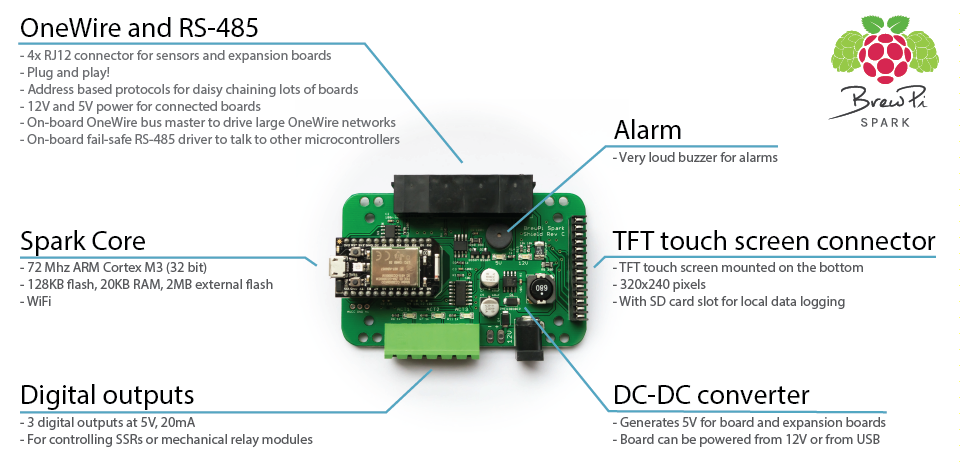
The BrewPi Spark
With this switch to a new platform, we decided to do a complete redesign of our hardware. We learned a lot from making the Arduino version of BrewPi and decided to do a major overhaul to address a few key issues:
Plug an play
The Arduino Shield came with a bag of parts, a separate display, Arduino and lots of panels to build the case. Assembling your brewing controller took a lot of steps, which where not all easy. With the new BrewPi Spark, we decided to not leave assembly to the end user. It will come inside an very pretty enclosure, ready to use. Just plug in your sensors and play!
A better display and menu
The character LCD on the Arduino version could only fit 80 characters. To display beer, fridge and room temperature, we had to alternate what was displayed on the screen. With our new 320×240 color TFT touch screen, we can fit 1500 characters in the smallest font. So there is plenty of space to display all your settings and temperatures.
The touch interface will also be a lot more intuitive to use.
Reliability
We took 3 steps to increase reliability of the system:
- Sensors now come with RJ11 connectors
- High quality push-fit terminal blocks for the SSRs: easier to use and more reliable than the previous screw terminal blocks.
- An on board OneWire bus master with strong pull-up. This will increase reliability in large OneWire networks.
Local data logging
The BrewPi Spark has an SD card slot for local data logging, in case WiFi is not available.
Modular and expandable
The BrewPi Spark is designed to be a central control unit for your entire brewery. So why does it only have 3 outputs and 4 inputs? (Hint: it doesn’t).
Almost all brewing panels I have seen so far have a central control panel with a wire going to every sensor. When I started designing my mashing system, I quickly realized that this would become one big mess of wires: my HERMS has 6 temperature sensors, 12 motorized ball valves, 2 pumps and 2 heating elements. So I needed a different solution, and that was address based communication.
Each RJ12 socket on the BrewPi Spark has the same 6 signals:
- OneWire
- RS-485 (2 pins)
- 12V
- 5V
- GND
Both OneWire and RS-485 are address based protocols: you can connect as many devices as you like and they will be automatically discovered. You can then name the device and set it up for control. OneWire will be used for temperature sensors, valve controllers, SSR drivers and more in the future. RS-485 will be the protocol to talk to other micro-controllers for more complex sensors later.
So how does that work in a brewing setup? Here is a sneak preview of my HERMS. In a future blog post I’ll tell you everything about it. It really deserves its own post.
As I said before, my HERMS has 6 temperature sensors and 12 ball valves, controlled by 6 dual ball valve controllers. These are all on the same OneWire bus. In the photo below, you can see 6 of my ball valves, which determine to which kettle the water or wort is pumped.
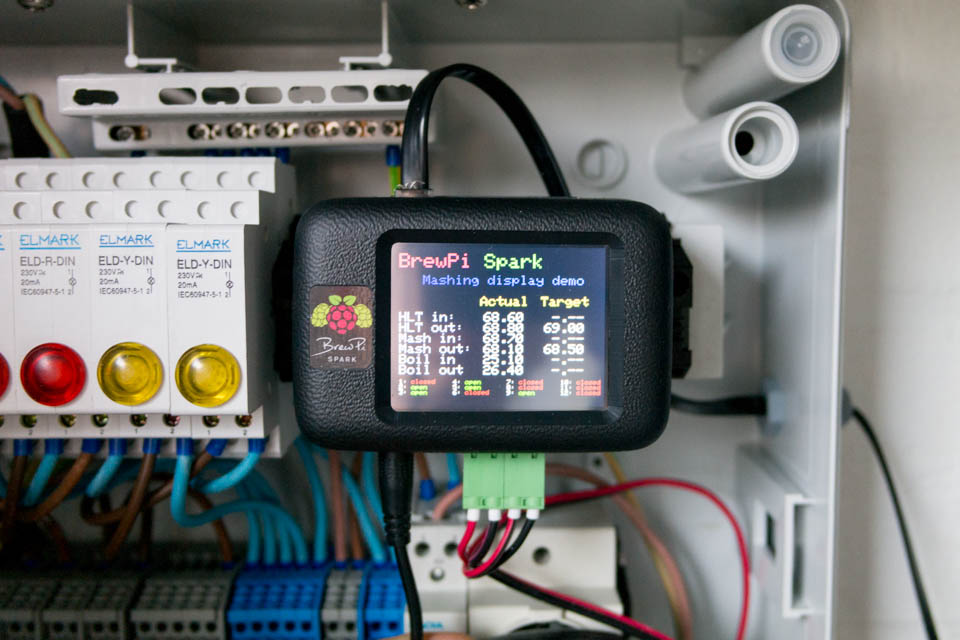
Here is the controller in my HERMS control panel. As you can see, only a single cable comes out at the top. This cable connects to all sensors and ball valves in my setup.
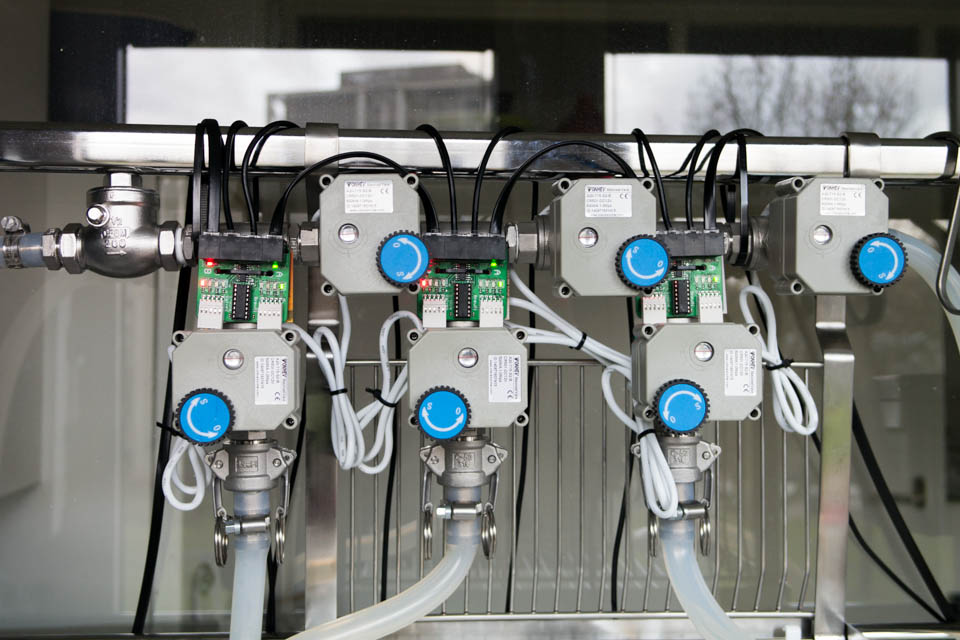
My ball valve controllers, daisy chained with temperature sensors in between.
In the photo you can see 12 RJ12 sockets and plugs (3 x 4). The leftmost cable comes from the control panel. The fourth cable in each block daisy chains to the next block. In the middle of each block, 2 temperature sensors are connected. Here you can really see the benefit of a bus protocol: wiring is a piece of cake!
Multiple fridges? Mash and fermentation control together?
The Spark Core is powerful enough to run multiple control loops at once. So you should be able to just run an RJ12 cable to your fridge on the other side of your brewery and set up another controller in the software. To make it easy to do this, we are going to sell an SSR expansion board. It is controlled by OneWire and drives 2 SSRs. It has 4 RJ12 sockets, so minus the cable coming in, you have room left to plug in 3 temperature sensors.
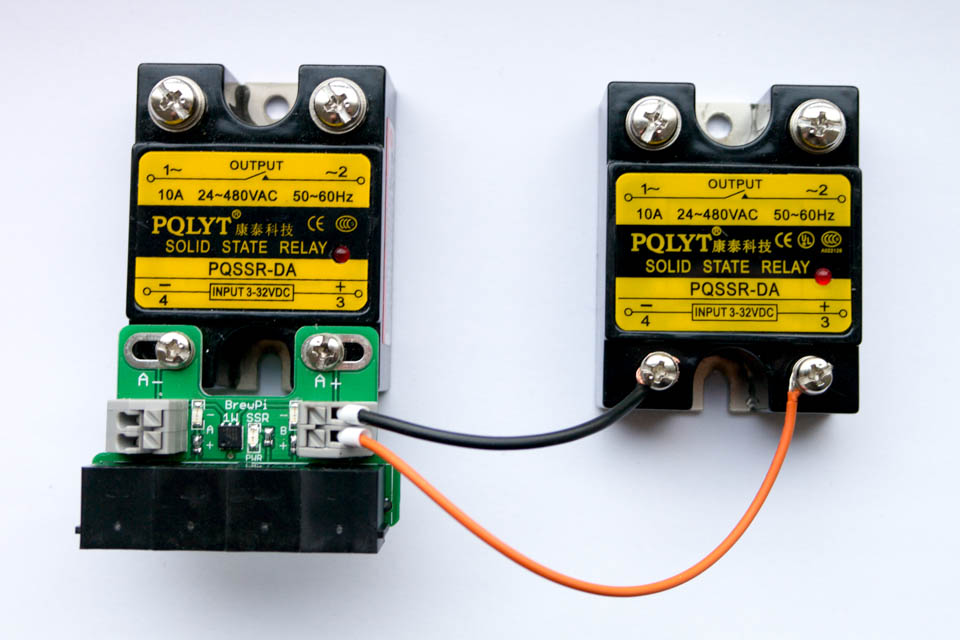
New temperature sensors
From now on, we are going to sell our OneWire temperature sensors with an RJ11 plug (RJ11 connects to middle four pins in RJ12 sockets). They will still have silicone cables and will be guaranteed water and high temperature proof. We increased the cable length to 1.5m.
Next to the standard temperature sensors, we will also offer threaded OneWire sensors that can fit into a BSP or NPT tee. The cables can be disconnected for when you need to clean your kettle.
What about the Raspberry Pi?
BrewPi will still use the Raspberry Pi for the web interface and for data logging: the Spark Core is not powerful enough to host a website. But without the need for a USB connection between the controller and the pi, it will be easier to swap out the Pi for a different web server.
With this combination of an embedded device for control and a (mini) computer to host a web interface you get the best of both worlds: The reliability of an embedded platform and a beautiful web interface.
In the future, we will also support connecting multiple Spark cores to a single web interface.
What about the Spark Photon?
The Photon is the successor of the Spark Core and will come out in March 2015. They managed to cut the price in half, while increasing the processor speed and memory space. It is pin compatible with the current Spark Core, so we decided not to wait for its release and work with the currently available hardware.
When can I order?
The controllers are almost ready, the enclosures are still being manufactured. Due to the Christmas holiday, I probably cannot ship the first units until January.
I have not found the the time yet to get our new web shop ready for pre-orders: making the controller, building my HERMS, testing, it was all a lot of work.
Because many people have inquired about giving BrewPi as a Christmas gift, I still wanted to announce our new controller today. Now you know why the old controller is out of stock!
What will they cost?
The BrewPi Spark, fully assembled with a Spark Core, inside will cost 125 euro. If you already have a Spark Core, you can buy the board, display and enclosure for 95 euro.
Christmas Gifts
As soon as possible (hopefully tomorrow), I will add the option to buy gift cards to our shop. That will buy me some time to properly add all the items to our store and the brewer you love can pick his own toys, so you don’t have to guess what he needs.
If you already have a pending order in our shop and want to convert it to a gift card, let me know by e-mail.

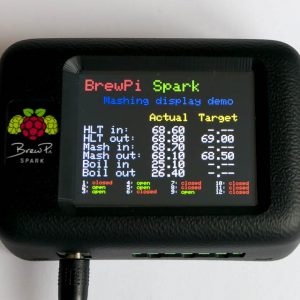
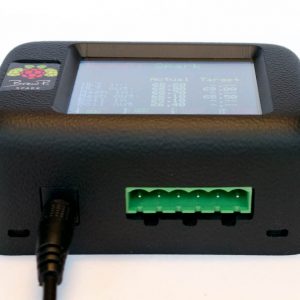
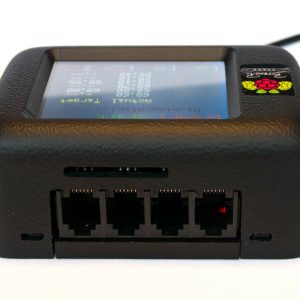
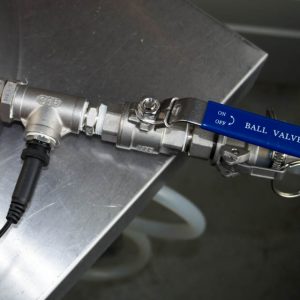
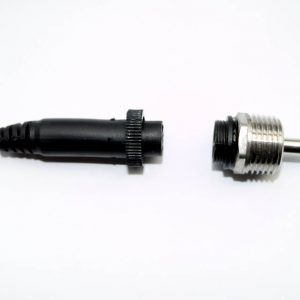
Looks well thought out. I can’t wait to see the structure of the software. How do you plan on mounting the Brewpi case? In your big panel or separately?
We designed a small wall bracket for it. For my HERMS panel, I am going to mount in on the DIN rail inside the enclosure.
Super excited about this. I’ve been playing with a spark core for a few weeks now. My biggest question is will there be a phone app to talk to it at all? I don’t really care about the historical data or even profiles. So not having a server running somewhere would be great. I just want to be able to start/stop temp control and double check where the temp is at right now. The phone app could also be a great way to get notifications if there is a temp problem.
There will be several levels in the API, of which the lowest will be at the Spark level. So it should be possible to write a phone app to interface directly to the spark.
Cool! That answers my next question of if it could run standalone (without the web interface on the pi) if you don’t care about the logging.
Elcoe,
Will we be able to program step mashes? If so will they need to be programmed manually or can recipes from BeerSmith be imported for utilization?
Looking forward to the big overview post in Jan.! Thanks for sharing
Mike
I think I would prefer to integrate with an online tool like Brewers Friend. I use BeerSmith too, but it annoys me at times. And their online stuff is not that great (their cloud).
The online tool should be a one stop integrated site that shows the actual brew data, recipe, history, etc. BeerSmith is not the right candidate for that I think.
Elco,
First of all Merry Christmas!
I will look at Brewers Friend but I have not found a better tool for tailoring water than BeerSmith (my third tool). But tools aside will your new system support doing step mashes? If it cannot I would consider that a significant shortfall.
Don’t worry, I consider that a basic feature. It is analogous to the fermentation profiles we already have.
Very cool! Do you have part numbers/recommendations for the 1-wire ball valves?
The valves do not have OneWire, it is an addon board I designed myself.
Valves and the OneWire board will be added to the shop in January.
Does the current oneWire code support the max31850 chip? I’d like to purchase a brew pi (2 actually). One to control my fermentation chamber and the second to track thermocouple temps in my wood fired oven. If it supports the max31850 I assume I can attach the chip and thermocouple to the oneWire bus of the brew pi? I know this is outside the box and I don’t really expect any tech support on it, just curious if the code would support it. I was going to build something for the oven, but it wouldn’t come out as clean as the brew pi and it would be nice to have all the charting functions.
Thanks
I already sampled some of those chips, but I still have to get started using them. The BrewPi Spark would work with them, but the software library has to be added. This would be quite trivial.
I do plan to make a small board for them and add a module in the software to support them. They make the most sense to use BrewPi for higher temperatures.
Great news! I assume that since the Spark is 3v I wont need any level shifting circuit between the BrewPi bus and max31850 chip?
Is it configured for parasitic power?
Looks pretty cool Elco. Will this version be compatible with glycol chilled fermenters or still only used with fridge/freezers?
I plan to, but I still have to wrap my head around how Glycol is different in terms of control.
The way I think the software should work is very flexible for any kind of process. The software is still a work in progress, so I cannot say it works right now, but I can say it is definitely on the road map. Anything beyond the home brew scale is on glycol chilling, so we’d be silly not to support it.
Hey Elco-
We have had a few comments back and forth about using this system for glycol chilling small fermenters on the support page. I am still interested in looking at how this would work for a glycol system and willing to help in any way possible. I run the Nano program for Boston Beer, and am always looking for ways to improve our brewery. I don’t know much about this technology or the programming behind it, but have been trying to read up on it since stumbling upon your site. Please don’t hesitate to contact me for any input or testing of a system.
Cheers,
Eryn
Hi Eryn,
I don’t know a lot about glycol yet, but I have been in contact with someone who does and might be able to help you get a BrewPi glycol setup running. I’ll contact him and introduce you guys. We might be able to get something going together.
Elco
This is probably pretty obvious, but is my understanding correct this could replace (and potentially do a lot more than) the control panel that is used by Kal with his electric brewery on the electricbrewery.com?
Yes, that is the plan.
I built an electric HERMS inspired by Kal’s build, but with modifications and custom parts to make things better. I will post a lengthy update detailing the HERMS in the first week of January.
Will there be support for 110v and NA plugs?
The controller does not have sockets to plug in an appliance directly, it only has digital outputs to control an SSR. So if you want to have a controllable socket, you have to wire an SSR yourself and you can choose the socket yourself.
Right, I figured that out after my comment. The plug and play note above through me at first.
So I’m looking for a controller and found your site in my search. Looks great. Looks like it’ll be a better alternative to the BCS. How much are temp sensors and etc. going to cost to complete the system?
A basic temp sensor, like the ones in the old shop, but with a longer cable and an RJ12 plug will be 7,50.
A threaded probe with NPT or BSP thread that fits into a T-piece and a removable cable will be 18 euro.
The temp sensors will be quite a bit cheaper than in a Kal build, so you can add a lot of them. Price is about the same as with the BCS, but you get digital sensors.
So do you need the Raspberry Pi for web/logging or can you use any computer/tablet?
Any system that is always on and can run a web server should work.
Hey Elco,
I was wondering if you were going to just sell the board by it self? I don’t need the screen or case? Thank you
Joe
For this run, I am not. But I plan to make a new cheaper headless board for the next run.
I think this will be without RS-485 and without DC-DC converter. Just the Spark core, OneWire, Buzzer and digital outputs.
Thanks Elco. Sounds good. By chance how much longer until we can purchase them? I would like to be one of the first to get one. I was trying to get one of the BrewPi’s but you don’t make the shield anymore. I missed out on it. I don’t want to miss this one.
Am looking forward to ordering this, and getting it interfacing with an Android App. Would opensource the Android app on github.
Brian
Any update on release date? Need another brew pi, and would rather get the newest one.
Just released! New store is online!
The post is a bit confusing.. So this is not going to replace the fermentation chamber or is it or will it have 2 modes brewing and fermenting. It’s interesting… so the spark will replace raspberry pi + arduino ?
The Spark will not replace the Raspberry Pi, it does not have enough processing power and memory to run a web server.
It will replace the Arduino and talk to the web server.
It will have multiple modes, but the goal is that it eventually controls your mash and your fermentation chamber(s) simultaneously.
Is there already a “manual” available for the Brewpi with Spark. And when will the necessary scripts be available?
No not yet actually. We are still working on gui drivers and the updating/programming process. It will be posted before they ship
one other question that just popped into my head. Will the board be compatible with the photon when it is released?
Yes, definitely. The photon will be pin compatible with the spark core.
How many fermentation chambers can be run simultaneously at different temperatures?
I cannot give you an answer to that yet, because we are still working on the multi-chamber software. I don’t think there will be a limit that you are likely to hit.
Any details about the GUI for brewing? I love the brewpi I have running for fermentation, and I am really excited about this setup to replace my control panel.
Not yet, this month we are building the fermentation GUI for the new display. When that’s done we are going to add features step by step. One of the first will be to add PWM outputs, which will make BrewPi usable for mashing. But for a new interface with unlimited sensors and multiple control loops a lot has to change.
Curious, now that it’s March 2015, whether the Spark Photon will replace the Spark Core in the web store offerings. I’d rather not buy a Core-based unit with the foreknowledge that I expect to swap in a Photon pretty much right away. Or to express it in pseudo-code: I want to spend $[Photon], not $[Core + Photon]
I understand. I would much rather sell Photons as well, but they will not be available until the end of April. It is not something under my control, so it is up to you whether you want to wait for the Photon or not.
Will the Brew Pi Web interface be updated to contain Brewing controls?
Step mashing, boil control, hop timers and all the guuuud stuff one would like to control during brewing?
Will there also be (I hope) a recipe import function from BeerSmith, I know they can export in xml, so should not be a big issue?
Looking forward to ordering as soon as photon is ready and your web interface is updated 🙂 Will you also soon sell the newest/badest/hardcore raspberry pi?
Hi Dan, we have plans for all of that, but writing the software will take time. We will focus on setting a decent foundation for open source contributors to help us.
I will not be selling the new Pi. The minimum order quantity in bulk is 250 and even then the margins are shit. I still have quite a bit of stock of the model B+, which I am now selling at a loss, and I will not be making the same mistake again. You can buy them almost anywhere, so I am fine with not offering them myself.
But then I would like to ask, will your software work on the new raspberry pi? in case I will order one and start getting to grips with your web interface and how to develop gadgets for it 🙂
Thanks for quick answer!
Sorry to hear about your backlogged old rasps…. maybe make yourself a supercomputer ?
Best regards
Dan!
The Pi is just used as a web server, so basically any PC would do. We are not using the GPIO pins or any other rapsberry pi hardware specifics.
Are you selling the SSR onewire board yet? I don’t see it in the store. Would love to remove my cheap controller from the beer fridge and run both off of one controller.
Any updates on these?
Hey Guys,
What did you use to build the user interface on your display?
Thanks,
Nathan
It is built using eGUI.
any update about BrewPi Spark ?
A new version will be available in about 8 weeks.
Hi Elco
I have a job for the Spark to control 3 fridges with heaters and fans, are you still on schedule?
Thanks
John
I’m working on that, but behind on the schedule. With the release of the Spark V3, I’m going to try to have support in there for managing 2 separate processes, but complete freedom to add as many as you want will take a bit longer.